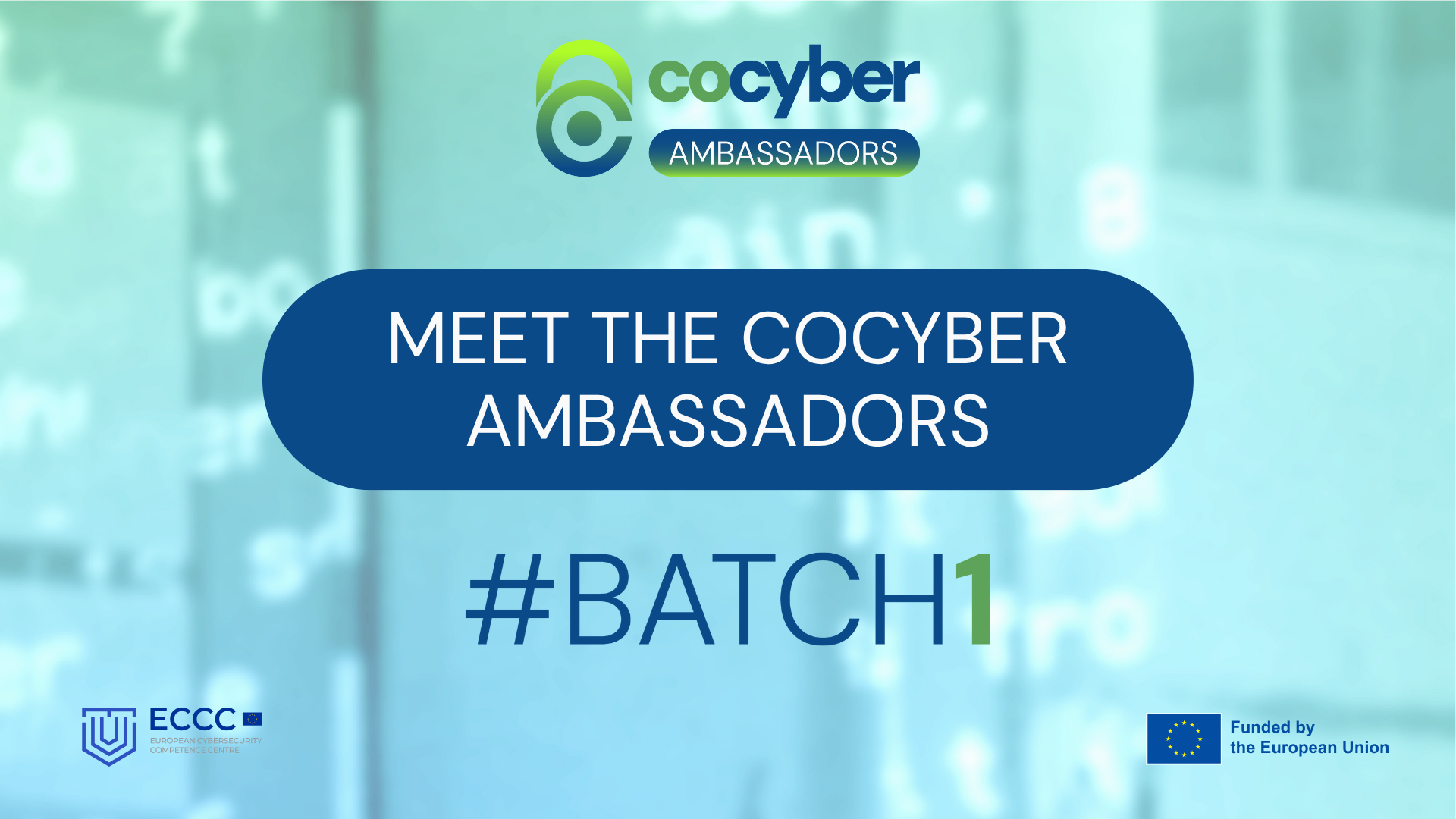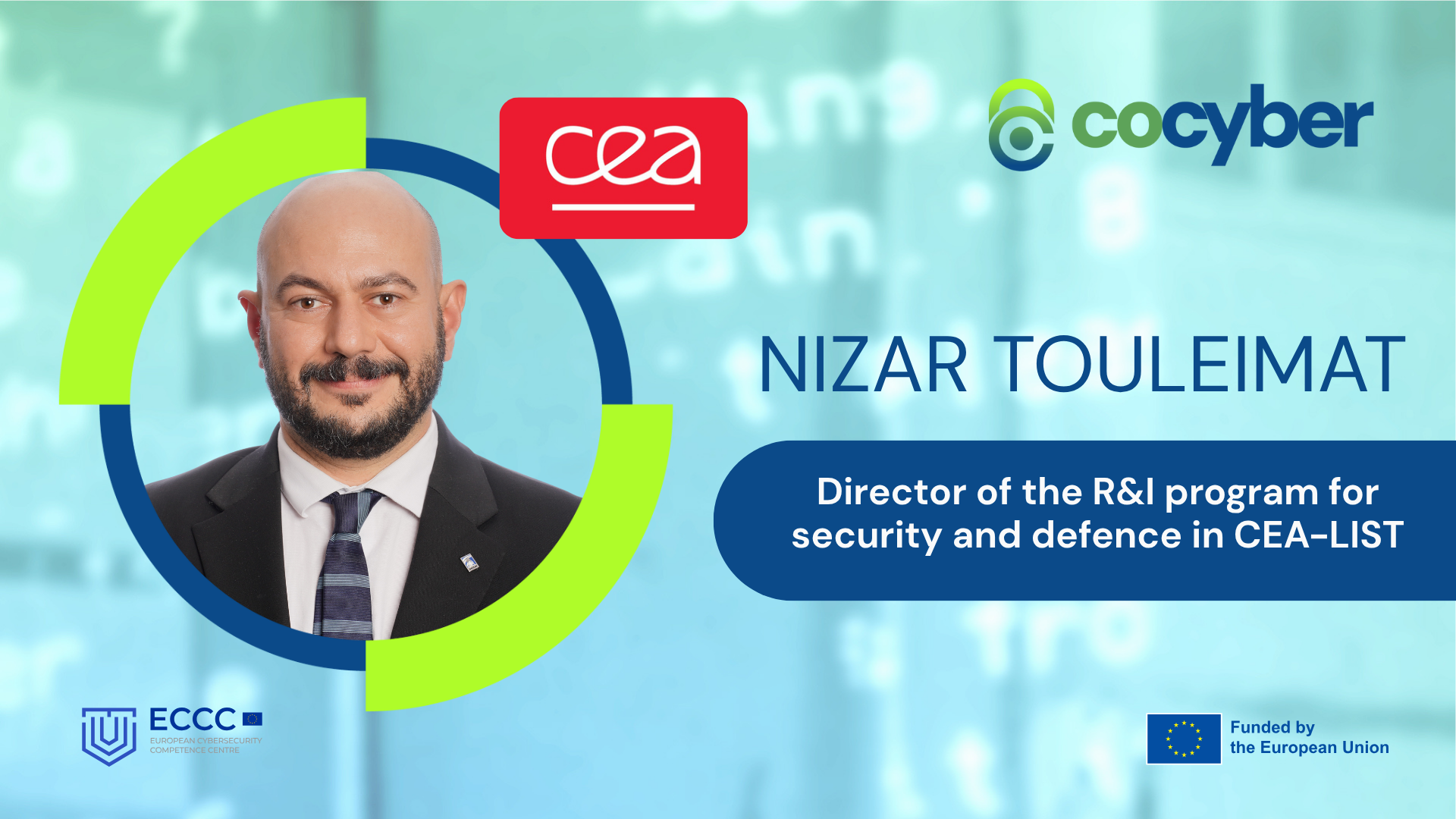COcyber Batch #1 Ambassadors in the Spotlight: Nizar Touleimat

Six months ago, the COcyber project launched the first round of its Ambassador Programme, an initiative designed to strengthen communication and engagement across Europe’s cybersecurity ecosystem. The programme brought external voices into the project’s outreach efforts, inviting experienced professionals to contribute through public dialogue, community engagement, and strategic insights.

As the first ambassador cohort concludes its mission, we’re taking time to reflect on each of their contributions, perspectives, and what they see as key priorities going forward.
In this article, we spoke with Nizar Touleimat to hear about his experience, his views on European cybersecurity, and his message as this six-month journey comes to an end.
Who are you, and what is your professional background?
I am the Director of the Research and Innovation programme for the application of Smart Digital Systems to Security and Defence at the CEA-LIST institute. My background as a research scientist includes extensive work in applying artificial intelligence to data science, with a strong focus on multidisciplinary and international collaboration. I currently coordinate the STARLIGHT project, which supports European sovereignty in AI for law enforcement and helps protect critical infrastructures from AI-powered cyber threats.

I also represent CEA in several European cybersecurity bodies, including ECSO, EACTDA, and EARTO, and I am a member of the European Commission’s CERIS expert group. I graduated from the French Institute for Advanced Studies in National Defence (IHEDN) with a focus on cybersecurity and digital sovereignty, and I serve as an operational reserve officer in the French Navy.
Since when and how are you involved in the European cybersecurity sector?
Since 2017, I’ve been working with the French Police Academy’s research laboratories on developing AI-driven digital forensic tools for use after cyberattacks. This led to further involvement in European R&D projects dedicated to protecting critical infrastructure, many of which integrate artificial intelligence into advanced cybersecurity solutions.
As coordinator of STARLIGHT and involved in the preparation of defence related European projects, I help lead the development of dual-use cybersecurity tools that support both civilian law enforcement and defence operations. My role connects strategic, technical, and operational perspectives across Europe, and through my ongoing advisory work with security forces and the European Commission, I contribute to shaping long-term approaches to emerging threats and digital protection frameworks.
From your perspective, what are the main challenges in the collaboration of the civilian and defence cybersecurity sector in Europe?
The rise of AI has significantly amplified and reshaped cyber threats, making coordination between civilian and defence sectors more urgent. However, the divide between them in terms of priorities, processes, and tools and the fragmentation of the cybersecurity ecosystem remain wide. We need greater investment in dual-use research and innovation to bridge this gap, improve our collective resilience and foster our European strategic autonomy and sovereignty.
There is also a long-standing divide between what is considered civilian versus military technology. Many emerging tools, especially in AI, are inherently dual-use, yet our systems and funding structures are still built around outdated distinctions. Aligning civil and military needs calls for mutual trust, clear strategic goals, and more inclusive mechanisms for collaboration.
Again, from your perspective, what are the most crucial steps to address these challenges and strengthen Europe’s joint digital safety efforts?
Europe needs to invest in collaborative research and development focused on dual-use cybersecurity technologies. These projects should be designed with both civilian and defence end-users in mind, using agile, co-creation-based approaches that allow for fast iteration and adoption.
We should also support more ambitious, high-risk research that has the potential to lead to disruptive solutions serving both sectors. Aligning priorities, pooling expertise, and focusing on shared vulnerabilities will help reduce fragmentation, strengthen interoperability, and reinforce Europe’s capacity to respond to complex and evolving digital threats.
In addition, as a representative of a large French Research and Technology Organisations (RTO) with important activities at the European level, I would like to highlight the crucial role of European RTOs in cybersecurity and cyberdefence innovation and the importance of involving them in the definition and implementation of R&D European roadmaps. In an era marked by increasing cyber threats and hybrid warfare, European RTOs are emerging as key actors in building Europe’s resilience and strategic autonomy in cybersecurity and cyberdefence. Their ability to conduct mission-oriented, secure research makes them indispensable in developing advanced technological capabilities that are both sovereign and interoperable within the EU and NATO frameworks.
RTOs provide trusted environments for research and testing in critical areas such as secure communications, cryptography, AI-driven threat detection, and resilience of digital infrastructures. They act as bridges between civil and military cyber research, enabling dual-use innovation that supports both national security and economic competitiveness. In particular, their work on secure-by-design technologies and cyber-physical system protection directly contributes to Europe’s preparedness against advanced persistent threats and digital espionage. Beyond technology development, RTOs also facilitate strategic collaboration between academia, defence actors, and industry. This intermediary role accelerates the transfer of high-potential research outcomes into deployable cyberdefence solutions. In alignment with European Commission priorities and the evolving objectives of the European Defence Fund (EDF), RTOs are thus essential to ensuring that Europe can anticipate, defend against, and recover from cyber threats — while maintaining control over the key technologies that underpin its digital and strategic sovereignty.
Did your experience as a COcyber Ambassador align with what you expected at the beginning and what are your key reflections now that the journey is ending?
Honestly, when I joined COcyber as an Ambassador, I expected to participate in a forward-looking initiative—perhaps more exploratory than operational—aimed at fostering dialogue between the civilian and defence cybersecurity spheres. What I didn't expect was the level of concreteness and strategic clarity the project would achieve in such a short timeframe.
From the outset, COcyber set ambitious goals: to bridge two often siloed and fragmented ecosystems, to promote dual-use innovation, and to contribute to Europe’s digital sovereignty and cyber-resilience. These goals sounded essential—but also abstract. Yet, what I witnessed over the course of the project was a very structured, impact-driven process that led to real, usable outcomes.

The PESTEL analysis, for instance, provided a remarkably comprehensive framework for understanding the policy and governance landscape. The COcyber Platform and Cybersecurity Observatory created an actual space for cross-sector collaboration—not just a concept. And the focus groups, flagship events, and the AI Cybersecurity Deephack directly contributed to identifying concrete challenges and co-developing practical solutions.
One of the most valuable takeaways for me was seeing how a European project could meaningfully support dual-use research, especially in high-impact areas like AI and cyberdefence. COcyber built mechanisms for it, and it created momentum for further cooperation between strategic communities that don’t always naturally connect. This is also very inspiring for me as the coordinator of the STARLIGHT European project, the flagship project of the EC for the development of AI-based solutions for law enforcement.
Looking ahead, I see real potential to build on the COcyber experience— in my role of expert for the EC, contributing to the elaboration of futur R&D roadmap via consultations and also through future EU-funded projects that take a dual-use approach to cybersecurity innovation. Whether through new consortia focused on AI-enabled defence resilience, joint cyber training platforms, or trusted testbeds for secure technologies, COcyber has shown that meaningful civilian-defence collaboration is not only possible—it’s productive and necessary. I'm genuinely excited about the opportunities this opens for future cooperation and long-term impact.

